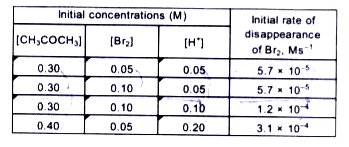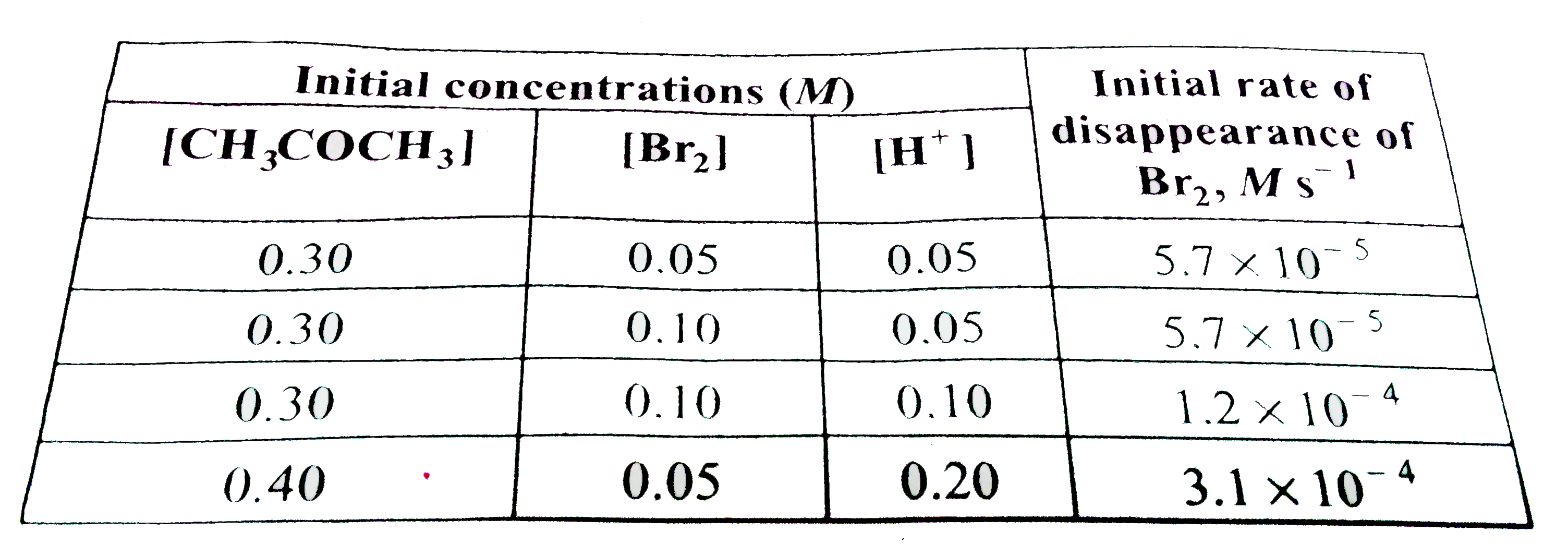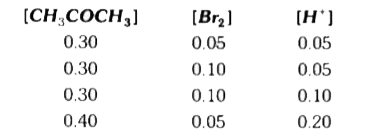The bromination of acetone that occurs in acid solution is represented by CH3COCH3(aq)+Br2(aq)→CH3COCH2Br(aq)+H+(aq)+Br−(aq)
These kinetic data were obtained for given reaction concentration

Based on these data rate equation is Solution in Malayalam
Rate =k[CH3COCH3][Br2][H+]2
Rate =k[CH3COCH3][Br2][H+]
Rate =k[CH3COCH3][H+]
Rate =k[CH3COCH3][Br2]
The correct Answer is:C
Rate k[CH3COCH3]α[Br2]β[H+]γ
Dividing eq(i) by eq (ii) 1=[12]βi.eβ=0
Dividing eq (i) by eq (iv) 5.7×10−53.1×10(^−4)=[34]α×[14]1
α=1 thus rate law will be rate =k[CH3COCH3]1[H+]1
Topper's Solved these Questions
- BOOK - BRILLIANT PUBLICATIONCHAPTER - CHEMICAL KINETICS EXERCISE - LEVEL I55videos
CHEMICAL KINETICS
- BOOK - BRILLIANT PUBLICATIONCHAPTER - CARBOXYLIC ACIDSEXERCISE - LEVEL-II (Assertion -Reason)4videos
CARBOXYLIC ACIDS
- BOOK - BRILLIANT PUBLICATIONCHAPTER - CO-ORDINATION COMPOUNDS AND ORGANOMETALLICSEXERCISE - Level-II (Assertion- Reason)4videos
CO-ORDINATION COMPOUNDS AND ORGANOMETALLICS
Similar Questions
The rate of combination of simple alkyl free radicals:
05:01View SolutionAssertion : p-chlorobenzoic acid is more acidic than p-fluorobenzoic acid.
Reason : +R effect of fluorine is higher than that of chlorine due to the matching size of carbon and fluorine.View SolutionAssertion : The complex ion [Ni(en)3]2+ has lesser stability than [Ni(NH3)6]2+
Reason : ln[Ni(en)3]2+, the geometry is square bipyramidal07:17View SolutionThe bromination of acetone that occurs in acid solution is represented by this equation. CH_(3)COCH_(3) (aq) + Br_(2) (aq) rarr CH_(3)COCH_(2) Br(aq) + H^(+) (aq) + Br(aq) These kinetic data were obtained for given reaction concentrations. Initial concentration, M {:([CH_(2)COCH_(3)],[Br_(2)],[H^(+)],("Initail rate) (disappearance of "Br_(2)),),(0.30,0.05,0.05,1.5 xx 10^(-5),),(0.30,0.10,0.05,5.7xx10^(-5),),(0.30,0.10,0.10,1.2xx10^(-4),),(0.40,0.5,0.20,3.1xx10^(-4),):}
View SolutionThe bromination of acetone which occurs in acid solution is represented by the equation:
CH3COCH3(aq)+Br2(aq)→CH3COCH2Br(aq)+H+(aq)+Br−1(aq)
The following kinetic data was obtained for the given reaction concentration:

Initial rates of disappearance of of Br2(Ms−1
5.7×10−5,5.7×10−5
1.2×10−4,3.1×10−4
Based on these data, the rate equation is:01:16View SolutionThe bromination of acetone that occurs in acid solution is represented by
CH3COCH3(aq.)+Br2(aq.)→CH3COCH2Br(aq.)+H+(aq.)+Br−(aq.)
These kinetic data were obtained for given reaction concentrations :

Based on these data, rate equations is :01:40View SolutionThe bromination of acetone that occurs in acid solution is represented by this equation
CH3COCH3(aq)+Br2(aq)→CH3COCH2Br(aq)+H+(aq)+Br−(aq)
These kinetic data were obtained for given reaction concentrations .Initial concentrations , M
[CH3COCH3][Br2][H+]0.300.050.050.300.100.050.300.100.100.400.050.20
Initial rate , disappearance of Br2,Ms−1View SolutionIn the reaction BrO_(3)^(-) (aq) + 5 Br^(-) (aq) + 6 H^(+) to 3 Br_(2) (l) + 3H_(2)O (l) The rate of appearing of bromine (Br_(2)) is related to rate of disappearance of bromide ions as following
01:26View SolutionThe order of the reaction
5 Br−(aq)+BrO−3(aq)+6 H+(aq)→3 Br2(aq)+7 H2O(l) is07:17View SolutionThe bromination of acetone that occurs in acid solution is represented by CH_(3)COCH_(3)(aq.)+Br_(2)(aq.)to CH_(3)COCH_(2)Br(aq.)+H^(+)(aq.)+Br^(-)(aq.) These kinetic data were obtained for given reaction concentration Initial concentration {:("Initial concentration",,,"Initial rate of"),(,,,"disappearance"),([CH_(3)COCH_(3)],[Br_(2)],[H^(+)],"of "Br_(2)),(0.30,0.05,0.05,5.0xx10^(-5)),(0.30,0.10,0.5,5.0xx10^(-5)),(0.30,0.10,0.10,1.0xx10^(-4)),(0.90,0.05,0.10,3.0xx10^(-4)):} Based on these data, order of reaction will be -
04:19View SolutionBased on data given below for the electrode potential , reducing power of Fe2+ , Al and Br− will increase in the order
Br2(aq)+2e−→2Br−(aq),E∘=+1.08V
Al3+(aq)+3e−→Al(s),E∘=−1.66V
Fe3+(aq)+e−2→Fe+2(aq),E∘=+0.77V03:37View SolutionThe bromination of acetone that occurs in acid solution is represented by
CH3COCH3(aq.)+Br2(aq.)→CH3COCH2Br(aq.)+H+(aq.)+Br−(aq.)
These kinetic data were obtained for given reaction concentrations :

Based on these data, rate equations is :04:19View Solutionएसीटोन का ब्रोमीनीकरण जो अम्ल विलयन में होता है, इस समीकरण द्वारा प्रदर्शित किया जाता है :
CH3COCH3(aq)+Br2(aq)→CH3COCH2(aq)+H+(aq)+Br−(aq)
दी गई अभिक्रिया सांद्रता के लिये निम्न गतिज आँकड़े प्राप्त हुए हैं। प्रारंभिक सांद्रता,M

Br2 की अदृश्यता की प्रारंभिक दर Ms−1 में हैं
(i) 5.7×10−5
(ii) 5.7×10−5
(iii)1.2×10−4
(iv) 3.1×10−407:13View Solutionअभिक्रिया BrO−3(aq)+5Br−(aq)+6H+→3Br2(l)+3H2O(l) में, ब्रोमीन (Br2) के प्रगटीकरण की दर, ब्रोमाइड आयनों के लुप्त होने की दर से निम्न प्रकार संबंधित है
View Solutionएसीटोन का ब्रोमीनीकरण जो अम्ल विलयन में होता है, इस समीकरण द्वारा प्रदर्शित किया जाता है :
CH3COCH3(aq)+Br2(aq)→CH3COCH2(aq)+H+(aq)+Br−(aq)
दी गई अभिक्रिया सांद्रता के लिये निम्न गतिज आँकड़े प्राप्त हुए हैं। प्रारंभिक सांद्रता,M

Br2 की अदृश्यता की प्रारंभिक दर Ms−1 में हैं
(i) 5.7×10−5
(ii) 5.7×10−5
(iii)1.2×10−4
(iv) 3.1×10−403:44View SolutionThe bromination of acetone that occurs in acid solution is represented by this equation.
CH3COCH3Br(aq)+Br2(aq)→
CH3COCH2Br(aq)+H+(aq)+Br−(aq)
These kinetic data were obtained for given reaction concentrations.
Initial concentrations, M
[CH3COCH3][Br2][H+]Initial rate, disappearance of Br20.300.050.055.7×10−50.300.100.055.7×10−50.300.100.101.2×10−40.400.050.203.1×10−4
Based on these data, the rate equation is02:25View Solution

